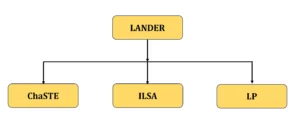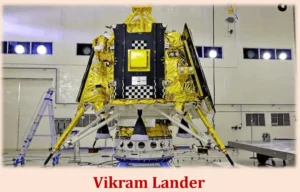
After the unsuccessful mission of Chandrayaan-2 on September 6, 2019, the Indian Space Research Organization(ISRO) is determined to make a remarkable comeback. It was marked with its newly launched lunar mission, Chandrayaan-3. Learning from the challenges faced in the former attempt, ISRO has been hard at work, perfecting technology and precisely planning every detail.
Chandrayaan-3 represents India‘s unvarying commitment to explore the Moon and understand its mystery. With renewed enthusiasm and determination under the chairmanship of K. Sivan and later taken up by S. Somanath in 2022, this mission aims to overcome obstacles and successfully land on the lunar surface, alluring the nation and the world with its scientific achievements. The entire design has been the concoction of ISRO scientist P.Veeramuthuvel.
Chandrayaan-3 comprises of a domestic lander module (LM), a propulsion module (PM) and a rover. With the aim of developing and showcasing new technologies essential for interplanetary missions. The lander is equipped with advanced technology to achieve a precise and smooth landing at a carefully selected site on the Moon.
Once safely landed, it will release the rover. The Rover will then autonomously traverse the lunar terrain, conducting detailed on-site chemical analysis of the lunar surface as it explores its surroundings. Both the lander and the rover carry scientific payloads for experiments on the lunar surface.
The primary function of the PM is to transport the LM from the launch vehicle injection to the final circular polar orbit (as illustrated in the above video by ISRO) of about 100 kilometers around the Moon and then separate from the LM. Moreover, the propulsion module not only serves its primary function but also accommodates a scientific payload that will be activated once the separation of the lander module takes place.
COMPONENTS OF CHANDRAYAAN – 3


ChaSTE(Chandra’s Surface Thermophysical Experiment) : Thermal conductivity and temperature measurement instrument.
ILSA (Instrument for Lunar Seismic Activity): Instrument to measure seismicity around the landing site.
LP (Langmuir Probe): Plasma density and its variation measuring device. It is passive Laser Retroreflector Array from NASA. It is capable for lunar laser ranging studies.
APXS (Alpha Particle X-ray Spectrometer): Device to determine the elemental composition (Mg, Al, Si, K, Ca,Ti, Fe) of Lunar soil and rocks around the lunar landing site.
LIBS(Laser Induced Breakdown Spectroscope): It is a instrument that will derive the chemical Composition. It will also infer mineralogical composition to further our understanding of Lunar-surface.

OBJECTIVES OF CHANDRAYAAN – 3
Chandrayaan-3 has been launched from Satish Dhawan Space Centre, Sriharikota, Andhra Pradesh on July 14,2023 at 14:35:17 hrs. It has used GSLV Mark 3 (LVM 3) heavy-lift launch vehicle. It will aim to perform safe and soft landing on southern pole of Lunar surface. The Rover will spend time and wander on the moon to conduct in-situ scientific experiments.
CHANDRAYAAN-3 SUPERIOR THAN CHANDRAYAAN-2
Chandrayaan-3 differs from Chandrayaan-2 primarily in two aspects. Firstly, it will not have an orbiter like its predecessor. Furthermore, Chandrayaan-3 will embark on its mission with an additional payload known as the Spectro-Polarimetry of Habitable Exoplanets (SHAPE). This is an instrument which was absent in the previous Chandrayaan-2 mission. The propulsion module of Chandrayaan-3 will be integrated with SHAPE. The objective of SHAPE is to gather data on polarimetric characterization of light reflected from exoplanets, which will be useful in the search for other planets exhibiting similar light signatures.
LESSON LEARNT FROM CHANDRAYAAN-2
After learning from the challenges encountered during Chandrayaan-2, ISRO engineers and scientists have made modifications to the software and hardware components of the upcoming Chandrayaan-3 mission. They have particularly focused on the lander thrusters. They have prepared advanced sequencing for soft landing. Further they have made several improvements in the lander, including the use of four thruster engines instead of five, stronger legs, expanded solar panels, and increased fuel capacity. The Chandrayaan-3 lander Vikram will also have the capability to generate power even when oriented in a different direction and will not be directly facing the Sun due to expanded solar panels.
ISRO has not officially shared a report specifying the reasons behind the failure of Chandrayaan-2. However, according to a retired ISRO engineer, the failure was due to a progressive reduction in velocity by the engine during the descent on the lunar surface, known as “throttling.”
FEW MORE CHANGES IN CHANDRAYAAN-3
As mentioned by the ISRO Chairman S.Somanath, the landing velocity of the Chandrayaan-3 lander has been increased from 2 m/s to 3 m/s. This adjustment ensures that even at a speed of 3 m/s, the lander will not meet with an accident or damage its legs.
Furthermore, Chandrayaan-3 has incorporated additional fuel in the lander to better manage potential contingencies and provide the ability to overcome unforeseen situations effectively. This increase in fuel capacity provides a greater margin for the mission’s successful execution.
ISRO has included a new sensor in the Chandrayaan-3 lander called the Laser Doppler Velocimeter. This sensor will aid in the study of the lunar surface. It will do this by using laser technology to measure various components of velocity. Integrating this sensor with the existing instruments improves measurement accuracy and provides a backup in case of any issues.
ISRO has made improvements in the Chandrayaan-3 software to handle potential anomalies. These includes engine failures, thrust issues, and sensor malfunctions, more effectively. In addition, a notable modification made for Chandrayaan-3 is the elimination of the central or fifth engine. It was incorporated during the later phases of the Chandrayaan-2 mission. These enhancements aim to increase the mission’s flexibility and reliability.
The Chandrayaan-3 lander, during the landing process on the Moon, will be equipped with “Lander Hazard Detection and Avoidance Cameras”. These instruments will assist in coordination with the orbiter and mission control. Instead of one camera, Chandrayaan-3 will have two cameras. These cameras play a crucial role in identifying potential hazards and ensuring a safe descent on the lunar surface.
CONCLUSION
The Chairman of ISRO highlighted that instead of implementing significant alterations, extensive testing was carried out. It was a crucial aspect of the preparations for the Chandrayaan-3 mission. Over the past two years, numerous tests have been performed. It included autonomous flights, helicopter flights, simulated landings using cranes, drop tests, and software simulations to assess potential failures and recovery options.

👍👍👍👍
Amazing
Helpful content👍
Helpful content 👍
Wow great for informative content 👌👌🙏🙏❤️
Informative
Very helpful sir. 👍
👍👍
Very Informative Content 💯
Very detailed and enlightening information.
Very informative
Very Informative Content 💯
Excellent! Information
Helpful content!!!
Detailed information 👍
Bahut acha